Sitting down and researching nursery management software out there on the market today can get overwhelming. Questions like: “Which features are valuable for my business” and “How easy will it be for my staff to use?” may be running amok in your head. And that is understandable! You need to choose a nursery management software and you want to do it right.
With companies such as Connect Childcare, eyLog, Famly, Parenta, and Blossom Educational on the market today, you may not know where to start! From our own experience of operating a group of nurseries ourselves – and speaking with our customers, we’ve broken it down into a comprehensive checklist to provide helpful insight into your decision-making. Hopefully, we’ve made the whole process a little faster.
1: What triggered you to start looking for nursery management software?
For this, think about any existing pain points your nursery has. What is it about your current systems, whether they are digital or manual processes, that present issues? Ask yourself: “Why am I looking for a change and what are the problems I want to solve?” For example, perhaps you’re facing an issue of having one invoicing system at your nursery and a different one to communicate those invoices to your parents. The problem you wish to solve is to stop spending time maintaining these different databases of records and eliminate the duplication of data entry.
Another pain point you could be struggling with is parent satisfaction. Perhaps you’re communicating with parents verbally which by nature makes the information (and frequency of communication) quite inconsistent. It is also dependent on who is giving the child over, as parents will most likely get different depths of information (and then have to remember it for later!).
Our suggestion: look at it from different perspectives!
As you know, different stakeholders are involved in the decision-making process when it comes to choosing a nursery management software to implement. Each will have different pain points they want to be resolved, and each will use the nursery management software differently. Look at it from 4 perspectives: You (the owner), the nursery manager, the practitioners, and parents:
From exploring features to avoiding common mistakes.
Here is a valuable checklist to help your setting choose the best software for you.
Owner
As the owner, you need access to different types of management information. You need to know, for example
- What is your fee income for the next month?
- What are your staffing needs, and other reporting information
- That your staff is being managed properly
Perhaps you see a staff member is spending too much time manually creating invoices and you want to reduce the admin burden for that person. Basically, from the software, you need data that enables you to make decisions for your business.
Nursery manager:
This is the person responsible for overseeing everything in your nursery. Most likely, they are currently spending a lot of time manually creating invoices or chasing payments.
Consider the following, they will:
- Be one of the power users of the system you choose
- Will provide training and development regarding the software
- Deal with any problems concerning the software
Therefore, their view on the current frustrations is very important.
Practitioner:
Your practitioners have their own frustrations. It may be that they are spending a lot of time on current systems which aren’t user-friendly – or that you have no system at all which may slow them down. All in all, practitioners generally have 3 major goals. They want to:
- Save time recording observations
- Make their lives easier and do the job more efficiently
- Spend more time with the children
Parents:
The parent view is very important to consider as, when put plainly, your parents are your nursery’s customers. They will want a few different benefits and outcomes from the software provider. Therefore, the Parent App from the providers needs to:
- Provide a window into their child’s life at nursery
- Make parents feel more involved in their child’s learning
- Details what their children are doing during the day
- Provide communication on how their child is learning, developing, and progressing.
- Cover diary daily factors such as:
- how much did they eat or drink today
- did they sleep
- were they ill
The Parent App from your nursery management software provides a point of difference. As you know, parents look at other nurseries to decide – not just yours. If you give parents reassurance that with this Parent App they will get all this fantastic information, it makes you stand out and could be the deciding factor.
2: Explore valuable features
When it comes to looking for specific features to have, this will depend on your individual pain points as explored above. Address these pain points with a prospective provider and ask how exactly your problems will be resolved by using them. It’s difficult to rank features because it’s the culmination of excellent tools that makes the running of your nursery that bit easier and more efficient.
When researching features consider:
- Will they be easy to use for the team or parents
- Is the system very outdated?
- What is customer support like?
- The system should be cloud-based (and therefore can be accessed from different devices)
- Features that manage the nursery as a whole
Child development:
Features for this purpose mainly must be able effectively to track children’s learning and development, and it must be in a way that’s accessible to practitioners. Such as an easy-to-use App. Additionally, it must translate what’s been put on the system to parents in an easily digestible way. Also, consider its reporting. Does the software provide termly reports that harness data already in the system (through observations)? You don’t want to manually create this report – the system must know.
Constant changes are happening in the nursery school industry. This year we’re dealing with a new EYFS framework. Therefore, it is vital that you choose a nursery management software that understands the industry and can adapt its service to best suit you and your nursery’s needs. Ask the question: when things change in legislation, will the provider update their system accordingly?
Here are the features that support Child Development which Blossom customers find very valuable:
- Cohort Tracking provides comparison and tracking reports And other valuable formative reports
- Diaries (meals, activities, nappies)
- Write detailed Observations
- Link to EYFS, CoEL, and Montessori
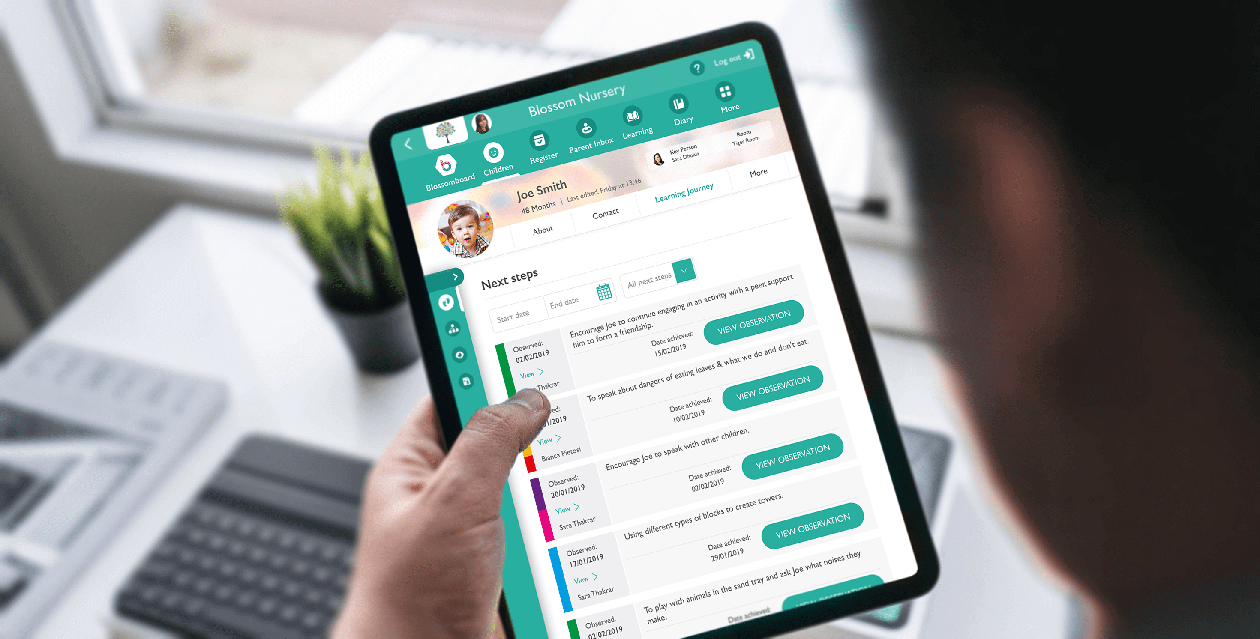
Parent communication:
When considering your parent communication during your decision-making process, you need to look at this with 2 main points in mind:
- Depth of functionality offered to parents (how much information do parents actually get)
- How easy is this information to access and digest. I.E. Is it messy to look at?
Essentially the parent app will be the face of the nursery to your parents. Therefore, it needs to be a priority when choosing a nursery management software. The software and Parent App are a reflection of the nursery itself. Does it cover things like:
- What children do on day to day basis
- Information about children's learning and development
- Reporting
- Administrative information e.g. receiving invoices
- 2 way messaging
A good Parent App can help boost your reputation and may even be a deciding factor for prospective parents. If they see that your nursery actively uses systems to improve their child’s life, they are more likely to join.
From exploring features to avoiding common mistakes.
Here is a valuable checklist to help your setting choose the best software for you.
Here are the features that support Parent Communication which Blossom customers find very valuable:
- Send Diary Updates which highlight a child’s moments during the day
- Learning Journeys to include parents in their child’s progress and development
- Paperless Billing as you can generate and send invoices directly to parents
- Home Observations via the Parent App
- Child Schedule which allows parents to keep track of booking pattern of sessions
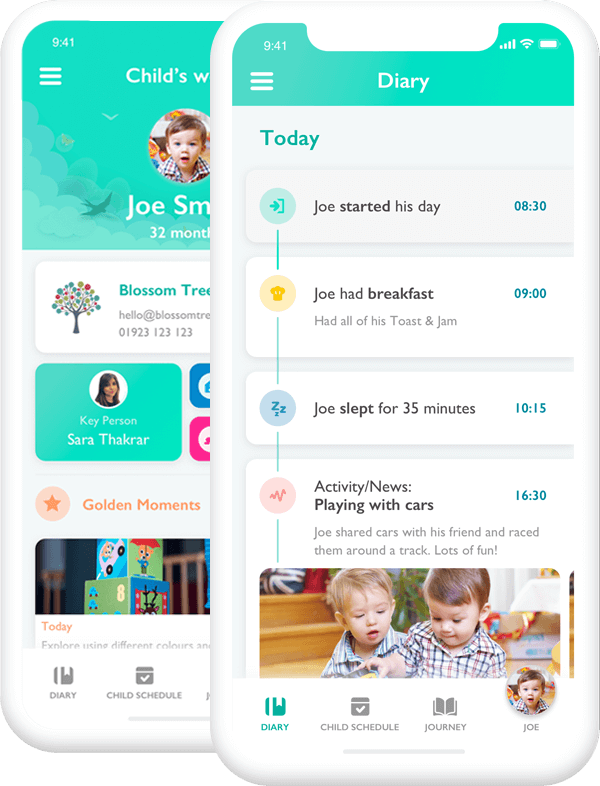
Billing and finance:
Nurseries bill in many different ways. A system that has the flexibility to align to the way you bill is key. You don’t want to change your financial model to fit a system. It should be the other way round! This is particularly important when it comes to funding. Check for factors such as:
- Are you able to charge for consumables?
- How do the invoices look to parents? There are legal requirements stating the way nurseries must present invoices and funding. Don’t get your nursery in any illegal or financial trouble at the fault of your chosen provider!
- Can you apply discounts to children easily?
- How does the invoice reach parents?
- Can you edit invoices to display information that is most important to the individual parent?
- Are you able to bulk generate invoices as a whole?
- Can you quality assure invoices before they go out?
- If parents decide to add extra sessions, can the invoices be edited easily?
On a management level, your software must be able to answer questions such as: how much have I billed for the next month and what is my income for the coming months? As you know, children leave, start, and sessions change. Can the software quickly and easily adapt to this? Consider how well the system manages payments. You also want to know whether your business has any debt or if any money is owed. The software should help to reduce and optimise your credit control process.Overall you are provided with reporting and data to properly assess how your nursery is running financially now and in the future.
Here are the features that support Billing and Finance which Blossom customers find very valuable:
- Generate and Send Invoices to parents which helps ensure accurate and on-time payments
- Create Funding Grants, and easily calculate and allocate them to sessions
- 7 different types of Financial Reports (such as financial forecasting)
- Maintain Accounts:
- Quickly log and keep track of payments
- Monitor transactions (such as debit and credit history)
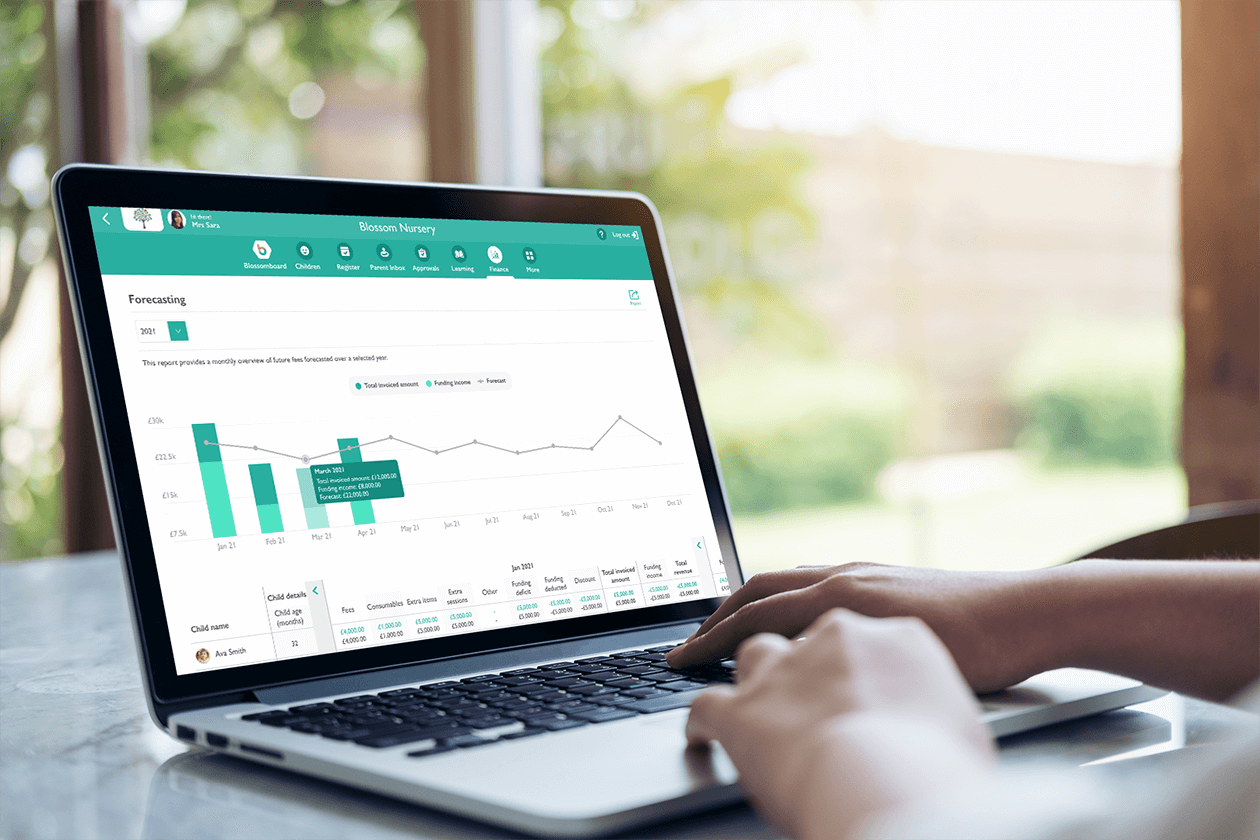
How many features are too many? It’s not necessarily the more the better with features. Often that ‘more’ can make things complicated. It may be feature-rich, but the average nursery manager doesn’t know where to start. Too much functionally coupled with a difficult interface or lack of clarity on different parts of the system can make things very difficult.
From exploring features to avoiding common mistakes.
Here is a valuable checklist to help your setting choose the best software for you.
Staffing and Occupancy:
These knowingly or unknowingly, are your nurseries biggest success or failure factors. When it comes to staffing, you need to provide a certain number of staff based on ages and the ratio of children present at nursery. And that makes it easy to be overstaffed. That is money wasted and could mean the difference between a profit or a loss for the day. Therefore, you want software that will prevent this from happening by covering:
- Staff rotas.
- Clear visibility of how many staff you require. Check whether the system takes into account whether children are absent or sick. This will of course affect your staffing allocation.
- Can you share staff rotas with the staff? Creating these rotas is often a mammoth task. Let this be automated by the software you choose.
Additionally, having the right granularity of information available on the system is vital. When it comes to occupancy, you want to be able to let potential parents know if you have space in your nursery (and at any time and any day of the week). Being able to have this data allows you to create balanced set-out sessions. Make sure that you can see in each Room which specific children you have attending nursery. Also, research the provider’s reporting capabilities. This is critical as it’s one thing having the information perfectly stored in your system, but how you get that information out is just as important. Check if these reports are in-depth and actually give you the information you want (and in an easy to read and understandable way).
For example, on photo day, the photographer may come in and takes pictures of the Butterfly Room. Your system must be able to provide a report detailing photo permissions to reduce wasting time and creating stress. Mainly, is it accessible?
Here are the features that support Staffing and Occupancy which Blossom customers find very valuable:
- Occupancy Planner lets you see easily available spaces across your setting
- Room and Room moves enable you to allocate staff to specific rooms
- Staff Profiles let you manage staff leave and more
- Shift allocation and payroll is simplified with Staff Worklog
- Occupancy Reports and Staff Planning lets you plan staff according to spaces
- Know exactly where you need to allocate staff on a daily, weekly, and monthly basis with Staff Rotas
- Staff Registers allows staff to clock in and out instantly
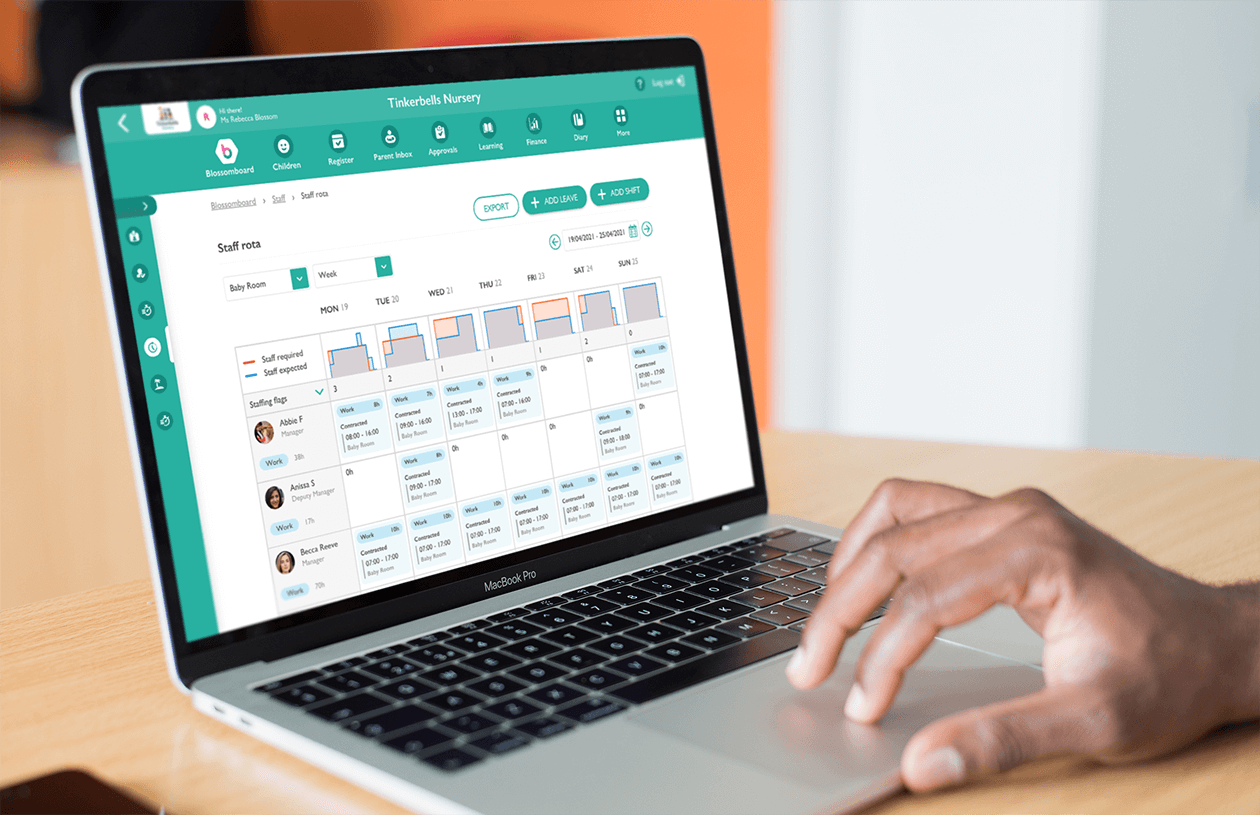
Reducing paperwork
What’s the point of choosing a digital system if you can’t get rid of your cabinets of files, right? Therefore, make sure that the system can store files at a nursery level and staff level (CVs, etc all of which are legal requirements of documentation you must store). Check if files can be uploaded easily and quickly. You also want to be able to store child documents. Ask if you can upload your own forms/ forms received from local authorities or parents as well. This ensures that the system is flexible to your needs.
From exploring features to avoiding common mistakes.
Here is a valuable checklist to help your setting choose the best software for you.
In terms of relevant features, consider the breadth and depth of features offered. How far can you go? Can I extract the report? Does it give me details on a child by child basis if I need it? Does it provide me with information 3 years into the future? This will help you to gauge. Also ask: how easy are the features to use? Do you press a button and wait for 10 minutes. If so, move on!
Here are the features that support Reducing Paperwork which Blossom customers find very valuable:
- Generate and send invoices online
- Diary updates let you get rid of paper diaries for each child
- Uploads Nursery, Staff, and Child files to the system itself for reporting, easy access, and safekeeping
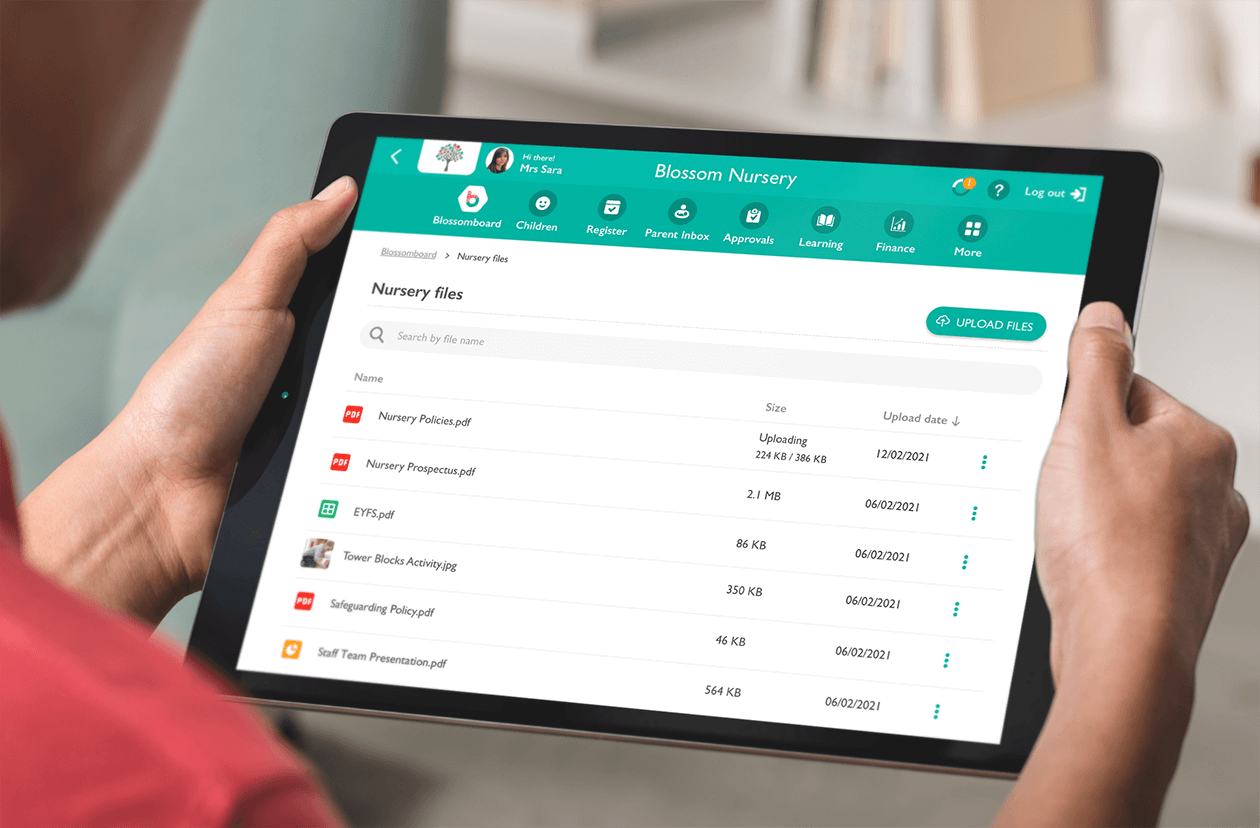
Deal breakers
Now that you have your pain points in mind, it is also valuable to spend time thinking about what are your deal-breakers. If you know, for example, that it is imperative for the software to handle invoicing, then software that does not offer this can be ruled out.
3: Avoid common mistakes
What do buyers often overlook? How long has the company been around for and how long are they going to be around? Consider the longevity of the company. You will rely on this company to run your business in essence and it touches everything in your business. From parent communication to reporting to fiances. So you need to ensure it’s not going anywhere anytime soon.
We suggest choosing a provider that is:
- Ideally local to you
- Invests continuously in making their software better
- Has a team of people who run the company who are industry experts
Good providers will have a team who are continuously seeking customer feedback and develop their software based on this.
During your demo, ask the nursery management software what features they released last or most recently, and what they plan to release in the future. This shows that they are willing to put a constant investment into their product.
4: Make sure it’s easy to use
This is a biggie. You don’t want to end up with software that offers valuable features but it’s too clunky or difficult to use. You want software that is modern as older systems prove more difficult to use. We hear this term “user-friendly” being thrown around a lot but what does it actually mean? What must you specifically look for in a provider to ensure that it is pleasant and easy to operate?
There are a few different factors at play:
- How modern is the software? I.E Is it cloud-based? Can you access from any device (tablets and mobile phones)?
- How does it look? Don't scoff at this. Your chosen nursery management software will only be as successful if it has a good uptake.
- Ask yourself, are you able as a nursery owner/ manager to ensure that your staff will use the system (and well)?
- How easy is it to navigate?
- Can you get to different sections easily?
- Do you get lost in the App or do you know easily where you are?
- Does it load quickly? Or take ages?
If the right answers are given, you’ve found your match. And if not, the search continues. The best way to do this is to request a demo of the platform. This is an excellent route to seeing how the software works, and if it is user-friendly.
5: Find out the real price
We did not put pricing first, because while we all have budgets to stick to, there is no point in choosing software only because of price. What will your business achieve if you can afford the software but it doesn’t perform the tasks you need? Put plainly, that is a waste of money and time – two points that you are most likely looking to save. The right software for your nursery should save you masses on costs in relation to the fee.
Do your research beforehand. Most, if not all, nursery management software companies are open about their pricing packages on their websites. Take a look so that you have a ball-park figure of what you are willing to spend. It’s important to be reasonable. You can’t be considering spending £50 per year and expecting to get a bucket load of services and features. Unfortunately, a package like that does not exist.
One way to look at it is to think: affordability versus long-term gain. By this, we mean considering the return on investment by purchasing a nursery management software. The software you are considering buying will speed up time-consuming tasks (such as recording child observations) and therefore will end up saving you money in the long term. This can apply to every aspect of your nursery – depending on what the software can do. So what may look like a large sum at first, may end up saving you three times that amount in the long run.
6: Check for any hidden fees and costs
This circles back to your price research. Some providers charge extra setup fees and/or expensive training sessions. Considering that there is no getting around having the system set up and needing your staff (and you) to be properly trained to use it, this is where the costs can add up. So if the provider you are considering has a low annual fee, do not forget to check the training and set up costs. We recommend sitting down, whipping out the calculator, and actually doing the maths. This way you will know for certain what your actual costs are. Better safe than sorry.
7: Ensure they provide industry insight
When you are weighing up nursery management software, consider what value as a whole the software company offers your nursery. Check out their blog posts and social media pages to see what the company is communicating about the industry. Do they actually provide industry insight or are they only pushing marketing their system? During your demo, this would be a good question to ask well. Ask your demo-doer to send you some examples of downloadable resources or interesting content for you to look at later.
Why is this important if they offer good software, you may ask. You want your software provider to be in the know. In fact, if they have any EE specialists or practitioners on the team that’s fantastic. And if the software owns and operates their own group of nurseries – well all the better! The more they understand the industry, the chances are the better software features and general service they will provide. If they understand what your needs are as a nursery manager and/or owner, and understand what current topics/issues you are dealing with, they can offer better support to help your business.
8: Ask if they regularly update their software
That brings us to the next point: do they regularly update their system? You want to make sure that your provider updates their software fairly frequently. This will most likely improve your user experience of the software if the provider often improves its system. On top of this, it shows you that:
- They take feedback from their users seriously, and
- The provider uses modern tech to improve the experience of the platform
- They want to offer the best service possible
9: Research what is the public opinion
Finding out what the consensus is for the nursery management software you are interested in is another good step. If somebody already uses the provider you like and has an issue with them- you want to know. More importantly, you want to see what people are raving about.
Chat to other nursery managers about what systems they use (and if they’re happy with them). Take some time to read the reviews online about the provider. You could also check out Facebook groups and online discussion forums to see what members of the sector are saying. When looking at reviews, be sure to ask about the provider’s customer service. What is it like? Helpful? Friendly? Attentive? These are the reviews you are looking for. You want to make sure that they don’t drop you once they have your billing info.
10: How is their customer support and training?
You can find the best nursery management software out there, but it won’t be any good if the providers do not offer proper support and training. You do not want a provider to have the attitude of once the sale is closed that is the end and goodbye to you. Remember, if you are switching from another provider, your staff needs time to adjust to the new system. And they need training on how to get the most out of it. If you are switching over from paper, you may require even more attentive support. We’re not judging your tech-abilities here – just speaking from experience!
11: Ask the tough questions during your demo
We have put together examples of questions to ask or points to enquire about during your demo:
- Bear in mind how much the company is seeking to understand your nursery needs.
- Ask enough questions to understand the depth of functionality the software offers
- Make sure you understand the experience from the parent’s perspective
- Ask about the company’s road map (where are they headed in the future?)
- Do you seek feedback from customers?
- Think about whether they are over-promising
- Understand the user-experience
- Ask about the background of the company. How do they get knowledge? Do they outsource or have internal experts Outsourcing?
Subscribe to receive expert advice and tips from seasoned professionals in the early years sector.